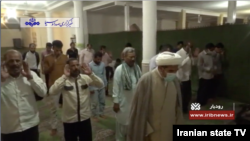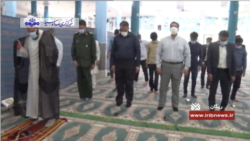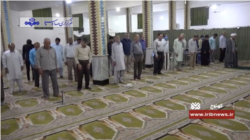Iranian state TV has shown images of worshippers ignoring government orders to wear face masks in mosques reopened by authorities in cities deemed to have contained the coronavirus.
In a TV report broadcast Tuesday by Iranian network IRIB’s affiliate in the southeastern province of Kerman, men and women were shown praying without masks in three of the province’s cities: Roudbar, Kahnouj and Manoojan. Only a mosque in Kerman’s Rigan county was shown in the report with all worshippers wearing masks.
Notably, the masked male worshippers in Rigan stood about half-a-meter apart, in accordance with another of the government’s guidelines to maintain social distancing while praying. Many Muslims typically stand shoulder-to-shoulder during group prayer as required by Islamic custom.
The worshippers in Kahnouj also stood about half-a-meter apart, although almost all without face masks.
In a Sunday announcement, Iranian President Hassan Rouhani authorized the reopening of mosques starting Monday in 132 counties designated as “white” areas where officials have said the coronavirus threat is low. Wearing face masks and social distancing during prayer were among the requirements accompanying that decision, along with limiting the time worshippers spend inside mosques to half an hour.
Rouhani began the process of restoring normal life to Iran in mid-April, allowing businesses to reopen while observing new health regulations to curb the nation’s coronavirus outbreak, the largest and deadliest in the Middle East. He shut down Iran's mosques, schools and much of the economy in March as the outbreak intensified, before saying the following month that the worst appeared to be over.
Rouhani’s deputy minister for elementary education, Rezvan Hakimzadeh, said in a Sunday TV interview that she expected elementary schools also to reopen in Iran’s “white” counties on May 16. Her boss, Education Minister Mohsen Haji Mirzaei, was more cautious on Monday, with Iran’s state-approved Tasnim news agency quoting him as saying that the reopening of Iranian schools in such areas requires a further decision by the government’s coronavirus task force.
In a sign of the riskiness of reopening Iran’s mosques and schools, Rouhani’s health ministry has acknowledged in recent days that the worst of the pandemic may not have passed.
In its latest data reported on Tuesday, the health ministry said the number of confirmed coronavirus cases rose to 99,970 — just shy of the 100,000 level already reached by nine other nations — while the official death toll increased to 6,340. International health specialists have said they believe Iran has underreported cases and deaths, citing perceived irregularities in Tehran’s official data and its lack of widespread testing for the virus.
On Monday, the Iranian health ministry said 15 of Iran’s 31 provinces were experiencing a second surge or peak of coronavirus cases, including Kerman, where worshippers were seen in the state TV footage praying without face masks on Tuesday.
In a Tuesday phone interview with VOA Persian, internationally acclaimed Iranian global health scholar Kamiar Alaei said the resurgence of the virus in the 15 Iranian provinces was a result of the government’s reopening of nationwide business activity three weeks earlier.
“Whatever policy you introduce (to restart or shut down social activity), it takes three weeks to see the impact (on the rate of coronavirus cases),” said Alaei, co-president of the Institute for International Health and Education in Albany, New York.
He said reopening Iranian mosques and schools in some areas is unwise because the spread of virus could intensify once again through the customary physical closeness of worshippers praying in groups and through the tendency of children to engage in physical contact at school and potentially infect family members at home.
“My prediction is that in the next two to three weeks, we will see another peak of the virus in more than 15 Iranian provinces,” Alaei said. “That’s why it is very important not to rush the reopening of society.”
Some Persian netizens who responded to VOA Persian social media posts on the issue were critical of Iranians returning to the reopened mosques and of government officials allowing those mosques to reopen.
One user who commented on a VOA Persian Instagram post accused the mosque attendees of not believing in science and endangering other people who are trying to stay healthy.
Another user who responded to a VOA Persian Twitter post opined that Iran’s ruling clerics were pushing for the reopening of mosques for their own financial benefit as they derive income from holy sites.
Iranian Supreme Leader Ayatollah Ali Khamenei controls several religious institutions that are exempt from government oversight and have enabled him to amass billions of dollars in personal wealth.
Expressing a different view, a Persian netizen responding to the Instagram post said the reopening of some mosques was not in itself a dangerous move. “What is important is how many people go to these places,” the user said.
This article originated in VOA’s Persian Service. Mehdi Jedinia of VOA’s Extremism Watch Desk contributed.








